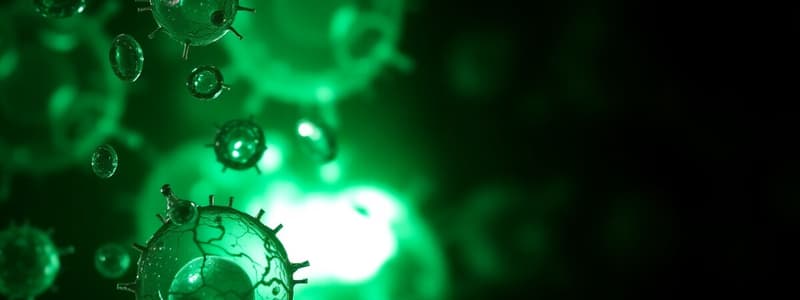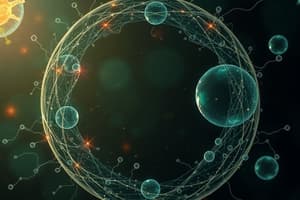Podcast
Questions and Answers
What is the main event occurring during the S-phase of the cell cycle?
What is the main event occurring during the S-phase of the cell cycle?
- Cellular growth
- Nuclear division
- Cytoplasmic division
- DNA replication (correct)
Mitosis consists of interphase and G0 phase.
Mitosis consists of interphase and G0 phase.
False (B)
What are the two main stages of the cell cycle?
What are the two main stages of the cell cycle?
Interphase and Mitotic phase
During the _____ phase, chromatin condenses into chromosomes.
During the _____ phase, chromatin condenses into chromosomes.
Match the following phases with their descriptions:
Match the following phases with their descriptions:
What characterizes the G1-phase of interphase?
What characterizes the G1-phase of interphase?
Cytokinesis happens during the G2 phase.
Cytokinesis happens during the G2 phase.
What is the purpose of the G2-phase?
What is the purpose of the G2-phase?
What is the primary role of the Ink family of proteins?
What is the primary role of the Ink family of proteins?
The Rb gene, when mutated, can lead to retinal cancer by allowing uncontrolled cell advancement through the G1 phase.
The Rb gene, when mutated, can lead to retinal cancer by allowing uncontrolled cell advancement through the G1 phase.
What is the role of the p53 gene in the regulation of the cell cycle?
What is the role of the p53 gene in the regulation of the cell cycle?
The active form of Rb is ____ phosphorylated and inhibits E2F-dependent gene activation.
The active form of Rb is ____ phosphorylated and inhibits E2F-dependent gene activation.
Match the following proteins with their corresponding functions:
Match the following proteins with their corresponding functions:
What primarily activates cyclin dependent kinases (CDKs)?
What primarily activates cyclin dependent kinases (CDKs)?
CDK activity varies throughout the cell cycle while CDK levels remain constant.
CDK activity varies throughout the cell cycle while CDK levels remain constant.
What is the role of Maturation Promoting Factor (MPF) in the cell cycle?
What is the role of Maturation Promoting Factor (MPF) in the cell cycle?
The cyclin that helps cells commit to DNA replication at the end of G1 phase is _____
The cyclin that helps cells commit to DNA replication at the end of G1 phase is _____
Match the cyclin class with their function:
Match the cyclin class with their function:
Which of the following proteins are considered negative regulators of the cell cycle?
Which of the following proteins are considered negative regulators of the cell cycle?
Tumor suppressor proteins act as positive regulators of the cell cycle.
Tumor suppressor proteins act as positive regulators of the cell cycle.
Cyclin D-CDK4 and Cyclin D-CDK6 are involved in the _____ phase of the cell cycle.
Cyclin D-CDK4 and Cyclin D-CDK6 are involved in the _____ phase of the cell cycle.
What is the main purpose of cytokinesis?
What is the main purpose of cytokinesis?
The G0 phase is a stage where cells actively divide.
The G0 phase is a stage where cells actively divide.
Name the three main checkpoints in the cell cycle.
Name the three main checkpoints in the cell cycle.
Cyclin Dependent Kinases (Cdks) partner with cyclins to form a ______ protein kinase.
Cyclin Dependent Kinases (Cdks) partner with cyclins to form a ______ protein kinase.
Which of the following is a characteristic of tumor suppressor proteins?
Which of the following is a characteristic of tumor suppressor proteins?
Match the following terms with their descriptions:
Match the following terms with their descriptions:
Cells can exit the cell cycle to enter the ______ phase, which is a non-dividing state.
Cells can exit the cell cycle to enter the ______ phase, which is a non-dividing state.
What do positive regulators like cyclins do in the cell cycle?
What do positive regulators like cyclins do in the cell cycle?
Flashcards
Cell Cycle
Cell Cycle
A series of events in eukaryotic cells leading to their replication.
Interphase
Interphase
The stage of the cell cycle before mitosis, with cellular growth, nutrient accumulation, and DNA replication.
G1 phase
G1 phase
The first phase of interphase, characterized by cellular growth and synthesis of enzymes for DNA replication.
S phase
S phase
Signup and view all the flashcards
G2 phase
G2 phase
Signup and view all the flashcards
Mitosis
Mitosis
Signup and view all the flashcards
Prophase
Prophase
Signup and view all the flashcards
Prometaphase
Prometaphase
Signup and view all the flashcards
Metaphase
Metaphase
Signup and view all the flashcards
Anaphase
Anaphase
Signup and view all the flashcards
Telophase
Telophase
Signup and view all the flashcards
Karyokinesis
Karyokinesis
Signup and view all the flashcards
Cytokinesis
Cytokinesis
Signup and view all the flashcards
Cytokinesis
Cytokinesis
Signup and view all the flashcards
G0 phase
G0 phase
Signup and view all the flashcards
Meiosis
Meiosis
Signup and view all the flashcards
Cell Cycle Checkpoints
Cell Cycle Checkpoints
Signup and view all the flashcards
G1 checkpoint
G1 checkpoint
Signup and view all the flashcards
G2 checkpoint
G2 checkpoint
Signup and view all the flashcards
M checkpoint
M checkpoint
Signup and view all the flashcards
Cell Cycle Regulators
Cell Cycle Regulators
Signup and view all the flashcards
Positive Regulators
Positive Regulators
Signup and view all the flashcards
Cyclins
Cyclins
Signup and view all the flashcards
Cyclin-Dependent Kinases (CDKs)
Cyclin-Dependent Kinases (CDKs)
Signup and view all the flashcards
Negative Regulators
Negative Regulators
Signup and view all the flashcards
Tumor Suppressor Proteins
Tumor Suppressor Proteins
Signup and view all the flashcards
Cyclin-dependent kinases (CDKs)
Cyclin-dependent kinases (CDKs)
Signup and view all the flashcards
Ink Family
Ink Family
Signup and view all the flashcards
CDK activation
CDK activation
Signup and view all the flashcards
CDK2-cyclin E/A
CDK2-cyclin E/A
Signup and view all the flashcards
Rb gene
Rb gene
Signup and view all the flashcards
Cyclin
Cyclin
Signup and view all the flashcards
Phosphorylation
Phosphorylation
Signup and view all the flashcards
pRb (hypophosphorylated)
pRb (hypophosphorylated)
Signup and view all the flashcards
pRb (hyperphosphorylated)
pRb (hyperphosphorylated)
Signup and view all the flashcards
G1 cyclin
G1 cyclin
Signup and view all the flashcards
G1/S cyclin
G1/S cyclin
Signup and view all the flashcards
p53
p53
Signup and view all the flashcards
p21
p21
Signup and view all the flashcards
S cyclin
S cyclin
Signup and view all the flashcards
M cyclin
M cyclin
Signup and view all the flashcards
Maturation Promoting Factor (MPF)
Maturation Promoting Factor (MPF)
Signup and view all the flashcards
APC/C
APC/C
Signup and view all the flashcards
CDK inhibitors
CDK inhibitors
Signup and view all the flashcards
CIP/KIP
CIP/KIP
Signup and view all the flashcards
Study Notes
Cell Cycle and Regulation
- Eukaryotic cells replicate through a series of events called the cell cycle
- The cell cycle is broadly divided into two stages: Interphase and the Mitotic phase
- Interphase (I) stage is characterized by cellular growth, accumulation of nutrients needed for mitosis, and DNA replication
- Mitotic (M) phase is where the cell divides into two daughter cells
- Interphase includes four phases: G1, S, G2, and G0
- G1 phase: the first phase in interphase, located between mitosis and S phase, characterized by variable duration, high biosynthetic activity and synthesis of enzymes for DNA replication
- S phase: DNA replication occurs, producing two genetically identical sister chromatids held together by a centromere
- G2 phase: period between S phase and mitosis, associated with rapid DNA control and preparation for division
- Mitosis phase is relatively brief, comprising nuclear division (karyokinesis) and cytoplasmic division (cytokinesis)
- Prophase: nucleolus fades, chromatin condenses into chromosomes
- Prometaphase: breakdown of the nuclear envelope
- Metaphase: alignment of chromosomes at the metaphase plate
- Anaphase: daughter chromosomes are pulled apart and move to the cell poles
- Telophase: daughter chromosomes at poles, spindle fibers disappear, cytoplasm divides to form two daughter cells with identical genetic information
- Exit phases:
- G0 phase: non-dividing (rest) state, associated with variable levels of differentiation (e.g., muscle and nerve cells).
- Meiosis: In germinal cells, it replaces mitosis and introduces genetic variation.
- Cell Cycle Checkpoints:
- G1 checkpoint: verifies the integrity of DNA before proceeding to S phase and DNA replication
- G2 checkpoint: verifies completeness of genomic DNA replication before mitosis
- M (Metaphase) checkpoint: monitors chromosome attachment to the mitotic spindle before anaphase and chromosomal segregation
Cell Cycle Regulators
- Regulatory proteins monitor and dictate cell progression through stages
- Positive regulators: control changes necessary for cell division
- Cyclins: G1, G1/S, S, and M cyclins, associated with specific phases
- Cyclin-Dependent Kinases (Cdks): enzymes that partner with cyclins
- Negative regulators: control positive regulators, include:
- Tumor suppressor proteins: Rb proteins and P53 proteins
- Inhibitors of Cdks (CDKIs): two types - Ink and CIP families.
- Specific examples of regulators are discussed, including the role of Rb and P53
Rb Gene
- Rb gene regulates cells' advancement from G1/S phase
- pRb arrests the cell cycle at G1 phase
- Mutated Rb gene leads to uncontrolled cell growth, potentially causing cancer (e.g., retinoblastoma)
- Rb regulation: active form is hypo-phosphorylated, activates E2F proteins to promote genes for S phase; in active cycling cells, Rb progressively become hyperphosphorylated, E2F binds DNA, activating genes important for S phase
p53 Gene
- p53 gene acts as a guardian, preventing the proliferation of damaged/genetically altered cells
- Can be activated by hypoxia, inappropriate oncogene signaling or DNA damage
- Activated p53 controls cell cycle arrest, DNA repair, cellular senescence, and apoptosis
- Activated p53 stimulates CKI gene, which produces p21 proteins to hold the cell cycle at G1/S phase, allowing DNA repair. If damage is irreparable, triggers apoptosis.
Studying That Suits You
Use AI to generate personalized quizzes and flashcards to suit your learning preferences.




